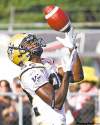Intent to injure or just good football?
Almost impossible to tell when players deliberately try to maim
Advertisement
Read this article for free:
or
Already have an account? Log in here »
To continue reading, please subscribe:
Monthly Digital Subscription
$0 for the first 4 weeks*
- Enjoy unlimited reading on winnipegfreepress.com
- Read the E-Edition, our digital replica newspaper
- Access News Break, our award-winning app
- Play interactive puzzles
*No charge for 4 weeks then price increases to the regular rate of $19.00 plus GST every four weeks. Offer available to new and qualified returning subscribers only. Cancel any time.
Monthly Digital Subscription
$4.75/week*
- Enjoy unlimited reading on winnipegfreepress.com
- Read the E-Edition, our digital replica newspaper
- Access News Break, our award-winning app
- Play interactive puzzles
*Billed as $19 plus GST every four weeks. Cancel any time.
To continue reading, please subscribe:
Add Free Press access to your Brandon Sun subscription for only an additional
$1 for the first 4 weeks*
*Your next subscription payment will increase by $1.00 and you will be charged $16.99 plus GST for four weeks. After four weeks, your payment will increase to $23.99 plus GST every four weeks.
Read unlimited articles for free today:
or
Already have an account? Log in here »
Hey there, time traveller!
This article was published 25/07/2011 (5220 days ago), so information in it may no longer be current.
How does one determine intent to injure on the football field?
That’s one of the big questions coming out of the Winnipeg Blue Bombers’ 33-24 victory over the Toronto Argonauts at Rogers Centre Saturday afternoon, a game that saw both starting quarterbacks — Buck Pierce and Cleo Lemon — take vicious shots to the head.
A hit by Argos linebacker E.J. Kuale drew an ejection for intent to injure on a helmet-to-helmet crack on Pierce and changed the course of events in the game. The other hit — a nasty blow from Bombers linebacker Joe Lobendahn that knocked Lemon’s bucket off (and Lemon out of the contest) — went unpunished.

Knowing part of the job description is to be physical, how does one determine the intent of a defensive player in a game that is born from toughness and exerting your will on an opponent?
“We teach guys to tackle, we don’t teach guys to hurt,” Bombers head coach Paul LaPolice said Sunday. “For an official to make a judgment on intent, what he goes off of is the actions of the player.
“Certainly they don’t know what’s going through the guy’s mind but they see what he does and they go off the actions.”
Kuale’s shot on Pierce was late — no question — and he took an extra step before delivering his body into Pierce’s frame. Just the pure optics of the play made it deserving of a 15-yard roughing the passer penalty, but does Kuale missile himself into Pierce’s grille?
It appears he does, slightly, but no more than he or anyone else would when making a tackle.
Seeing the helmet-to-helmet contact, referee Glen Johnson ruled rough play, that Kuale was trying to injure Pierce and he ejected the linebacker.
According to the CFL rulebook, rough play (usually reserved for acts like fighting) can be called when the referee sees an “act of excessive roughness” that warrants disqualification — a much harsher penalty than roughing the passer or unnecessary roughness.
And there’s the grey area that is up for debate.
“I guess they can measure intent. That’s what referees are going to do now?” Argos coach and general manager Jim Barker told reporters after the game. “What are you supposed to do? Stop playing hard? I don’t know the answer.”
Barker and the Argos were sour with the way Saturday’s game was officiated when it came to plays involving Pierce. Toronto had an interception taken away by a roughing the passer call on defensive end Ricky Foley, a call that prompted many on the Argos to wonder if all the league-wide talk about being physical with Pierce finally caught up with an opponent.
LaPolice isn’t one to stir the pot and he certainly wouldn’t take the spoon from reporters Sunday. His comments on the Pierce hit were carefully constructed, offering nothing past his assertion that the league made the right call.
As for the Lobendahn hit? Not surprisingly, the Bombers coach had no problem with it either, even after conceding that it was a helmet-to-helmet shot.
Different hits, he explained:
The QB has an understanding of protection when throwing the football, given his vulnerability in going through the act. The rules are clear about this. Once he pulls the ball down and leaves the pocket, he’s no longer protected by the rulebook (unless he gives himself up and slides) and the defence can treat him like any other ball carrier. Lobendahn, who could be looking at a fine from the league, was just making a tackle, LaPolice says.
True, but the helmets still crack together on contact and there’s no arguing that Lobendahn’s intent — or rather his actions, if that is what intent is defined as — produces the same result as Kuale’s intent on Pierce, but escapes penalty.
A spokesman for the league, which has fined two players this year for helmet-to-helmet hits, chose not to comment on the consistency of intent Sunday. Via email: “Our football operations staff meets to review and discuss the past weekend’s game. We would prefer to make any comments after we’ve had a chance to have that review.”
adam.wazny@freepress.mb.ca








